 Lalit Ahluwalia is committed to redefining the future of cybersecurity by helping large, medium, and small scale businesses build digital trust. Here, Lalit unveils twelve outcome-based strategies to help you prioritize trust in your cybersecurity program and unlock digital trust as an your organization.
Lalit Ahluwalia is committed to redefining the future of cybersecurity by helping large, medium, and small scale businesses build digital trust. Here, Lalit unveils twelve outcome-based strategies to help you prioritize trust in your cybersecurity program and unlock digital trust as an your organization.

Do you value trust in your business? Of course, you do. When it comes to safeguarding your organization’s data, reputation, and assets, trust is the bedrock upon which your cybersecurity program should stand.
In this article, we’ll explore a twelve-step, high-impact, outcome-based process that will empower you to prioritize trust in your cybersecurity program. You’ll learn how to fortify your defenses, foster a culture of security, build digital trust, and establish unwavering confidence in your digital domain.
The Cybersecurity Landscape
Imagine your organization as a fortress, with sensitive data and valuable assets at its core. The drawbridge is your cybersecurity program, and trust is the guardian standing vigilant at the gate. To maintain trust, you must adapt and evolve your defenses, keeping pace with the ever-changing threat landscape.
How To Prioritize TRUST In Your Cybersecurity Program
Step 1: Cultivate a Culture of Security
At the heart of trust lies a culture of security. You must infuse your entire organization with a deep understanding of cybersecurity’s importance. This begins with you, the leader, setting the example. Conduct regular cybersecurity training and awareness programs, ensuring every member of your team understands their role in the trust ecosystem.
Remember, trust isn’t just a technical endeavor; it’s a human one too. Make it clear that reporting security incidents or suspicious activities is not only encouraged but expected. Foster an environment where your team feels safe to speak up, knowing that their diligence contributes to the organization’s trustworthiness.
Step 2: Assess and Manage Risk
In this digital age, risk assessment is your compass. Identify the vulnerabilities and potential threats specific to your organization. What could go wrong, and how severe would the consequences be? Develop a robust risk management strategy that outlines how you’ll tackle these risks – whether through mitigation, transfer, or acceptance.
Step 3: Secure Your Digital Fortifications
Now, let’s fortify your digital castle. Regularly update and patch all your software and systems. This is your first line of defense against known vulnerabilities. Implement stringent access controls, adhering to the principle of least privilege. Only those who truly need access should have it. This limits the attack surface and enhances trust.
Step 4: Compliance and Regulations
Navigating the intricate web of cybersecurity regulations is essential. Comply with industry-specific standards and regulations. This showcases your commitment to trust and security, building confidence with customers, partners, and stakeholders. Remember, compliance isn’t just a checkbox; it’s a cornerstone of trust.
Step 5: Encryption and Data Protection
Your data is a treasure, and encryption is the lock. Encrypt sensitive data, both in transit and at rest. This ensures that even if an attacker gains access, the data remains unreadable and secure. Employ data loss prevention measures to prevent accidental or intentional data leakage, another critical aspect of trust.
Step 6: Third-Party Risk Management
In this interconnected digital world, your trust isn’t only as strong as your weakest link; it’s as strong as your weakest partner. Assess and manage cybersecurity risks posed by third-party vendors and partners. Ensure they meet your stringent security standards. Solidify these requirements in contracts and agreements, binding them to your trust ecosystem.
Step 7: Incident Response Plan
Trust can be fragile. When an incident occurs – and it’s a matter of when not if – your response is pivotal. Develop a comprehensive incident response plan. Define roles, responsibilities, and a clear chain of command. Conduct tabletop exercises and drills to ensure your response is swift, effective, and trust-restoring.
Step 8: Continuous Monitoring and Threat Detection
Trust is not a one-time achievement; it’s an ongoing commitment. Implement continuous monitoring and intrusion detection systems to swiftly identify and respond to threats. Utilize threat intelligence to stay ahead of the curve, proactively defending your digital domain.
Step 9: Transparency and Communication
Transparency is the currency of trust. Keep stakeholders informed about your cybersecurity efforts. Communicate openly in the event of a security breach. Share the steps taken to address the issue and prevent future incidents. This transparency builds trust and showcases your commitment to security.
Step 10: Cybersecurity Governance
Effective governance is the linchpin of trust. Establish a robust cybersecurity governance framework. Clearly define roles and responsibilities for cybersecurity decision-making. Regularly review and update your policies and procedures to adapt to evolving threats.
Step 11: Employee Training and Awareness
Your team is both your greatest strength and your potential weakness. Continuously train employees on cybersecurity best practices and emerging threats. Nurture a culture where security is a shared responsibility, and everyone plays a crucial role in upholding trust.
Step 12: Continuous Improvement
Trust, like a fortress, must evolve to withstand new threats. Regularly assess and improve your cybersecurity program. Conduct security audits and penetration testing to identify and address vulnerabilities. Adapt and evolve, so your trust remains unshakable.
Unlocking Digital Trust
Trust is the ultimate goal of your cybersecurity program. Prioritizing trust requires a holistic approach that combines technology, people, processes, and communication. By following this outcome-based process, you can fortify your digital assets, instill customer confidence in your organization, and stand as a beacon of trust in an increasingly advancing digital world. Remember, trust is hard-won and easily lost. Guard it with unwavering diligence, and it will safeguard you in return.
Related Articles
Six Outcome-based Strategies to Build Digital Trust
Challenges of Digital Trust In The Face Of Security “Blind Spots”
Enabling Data Protection From a Compliance to “Digital Trust” Perspective



